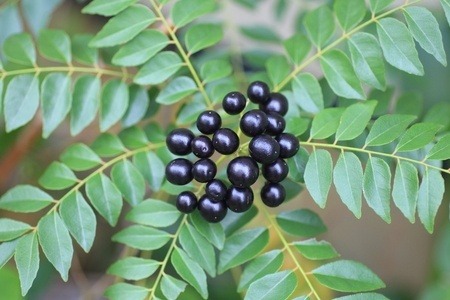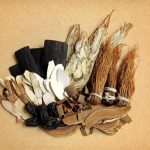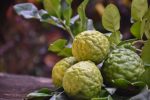
The curry patta, kadi patta (Hindi) or curry leaf tree (English) (Murraya koeingii Spreng. Family: Rutaceae) as its also known has long been used in eastern cuisine as a leafy vegetable, condiment and spice. Both fresh and dried leaves are used in cooking and medicinally.
The leaf oil is also known as Meethi neem in India and finds common use in soaps, hair conditioning products and other useful cosmetics.
There is accruing evidence it could be used to treat diabetic conditions as has been practised in Ayurvedic medicine for many centuries. It’s aromatic leaves make it ideal for the product developer too by generating curry like notes in Indian cooking and is used extensively to strengthen flavour in curries, suaces and chutneys in India (Peter, 1978; Philip et al., 1981; Joseph and Peter, 1985).
The plant is native to the tropical and sub-tropical regions of India.
The plant was first identified from samples collected in the Tarai region of Uttar Pradesh, India, and is commercially cultivated in Burma, Sri Lanka, China, India, Australia and the Pacific Islands especially the Ryuku Islands, Vanuatu and New Caledonia (Joseph and Peter, 1985; Smith). It is one of twelve species of shrubs or trees in the genus Murraya.
The medical properties have recently been reviewed (Bhandari et al., 2012) and there are extensive reviews on the plant and its composition by Ajay et al., (2011) and Gupta et al., (2011).
Flavour Of Curry Leaf
The leaves have a slightly bitter, fragrant, astringent, pungent and slightly acidic flavour. That flavour is unique and with its aroma generates a highly distinctive sensory experience as in curry. The dried leaves keep their flavour well.
Composition
The leaves are rich in vitamin A and C, and beta-carotene (Ramalakshmi et al., 2000). There are significant quantities of iron, phosphorous, vitamin B, calcium, fiber and carbohydrate.
Oils from the leaf have been analysed using gas-chromatography (GC) and GC/MS. These are mainly monoterpenes and oxygenated monoterpenes – α-pinene (19.0–19.7%), sabinene (31.8–44.8%), β-pinene (4.2–4.7%), α-terpinene (1.3–4.3%), β-phellandrene (6.5–7.9%), γ-terpinene (3–9-7.1%) and terpinen-4-ol (5.2–9-9%) (Mallavarapu et al., 1998; 2000). An analysis from 2004 identified 34 compounds in the following amounts: α-pinene (51.7%), sabinene (10.5%), β-pinene (9.8%), β-caryophyllene (5.5%), limonene (5.4%), bornyl acetate (1.8%), terpinen-4-ol (1.3%), γ-terpinene (1.2%) and α-humulene (1.2%) (Rana et al., 2004). The level of diversity of a number of factors such as oil composition has been explored further (Rao et al.,2011).
The plant is now one of the richest source of carbazole alkaloids (Rajendran et al., 2014). These are all antioxidants in their own right with the ability to mop up damaging free-radicals. The carbazole alkaloid, mahanimbine has interesting properties as an inhibitor of the acetylcholinesterase enzyme (Kumar et al., 2010). Three new carbazole alkaloids, mukoenigatin, bikoeniquinonine and murrayadinal, were isolated from the aerial parts of M. koenigii, along with mukeonine-B. Their molecular structures were determined on the basis of spectral analysis including ultraviolet (UV), infra-red (IR), mass spectroscopy (MS), and two-dimensional nuclear magnetic resonance (2D NMR) spectroscopy.
A number of other alkaloids such as murrayatanine-A, murrastanine-A and bismahanimboline jave been recently identified (Tan et al., 2015). These alkaloids are associated with their impact on managing diabetes (Patel et al., 2016) but one in particular koenidine appears effective in reducing postprandial rises in blood glucose.
We know of at least a couple of articles attempting to produce these novel alkaloids for diabetic research (Wang & Hoye, 2016; Yan et al., 2017).
Curry Leaf Impact On Diabetes
The first early studies in obese mice showed that injected extracts of curry leaf could reduce blood sugar levels – a strong hint of its antidiabetic benefits (Xie et al., 2006). Other animal studies reveal further anti-diabetic effects. Oxidative stress and damage are common end-points in a host of diseases such as diabetes, atherosclerosis and rheumatoid arthritis. A revealing examination showed just how powerful curry leaves are as antioxidants when it effectively protected pancreatic beta-cells from oxidative damage (Arulselvan & Subramanian, 2007).
The diabetic benefits have also been shown in rat models. Curry tree leaves have been fed to normal rats in a specialised diet incorporating the leaf at a 10% w/w level for 60 days. The study demonstrated a hypoglycaemic effect and an improved liver glycogen content because glycogenesis increased and both glycogenolysis and gluconeogenesis decreased (Khan et al., 1995). A dietary supplement using curry leaves increased the levels of lecithin cholesterol acyl transferase (LCAT) activity (Khan et al.,1996) which is important for fat mobilisation.
An aqueous extract of curry leaf can inhibit the enzyme paraoxonase 1 (PON1) which is a HDL-associated antioxidant enzyme (Saha & Mazumder, 2013). It means curry leaf extracts could decrease oxidative stress associated with diabetes.
In human studies, curry leaf powder supplementation where 12 g provided 2.5 g fibre for a period of 1 month in 30 (non-insulin dependent diabetes mellitus) NIDDM patients demonstrated a reduction in both fasting and post-prandial blood sugar levels after 15 days. There were no significant changes in a number of factors such as serum lipids, total amino-acids, lipoprotein cholesterol levels, serum glycosylated protein levels, glycosylated low density lipoprotein cholesterol fraction, and uronic acid (Iyer and Mani, 1990).
Cancer Destroying Benefits
There is increasing interest in its ability to destroy certain cancer cell lines (Ahmad et al., 2014). It’s worth noting that curry leaf is not being touted strongly as an anti-cancer agent.
Reduction Of LDL-Cholesterol
A study on mice showed that injection of curry leaf extracts could reduce the formation of LDL-cholesterol (low-density lipoprotein) or ‘bad’ cholesterol because it stops oxidation of cholesterol by blocking free radical damage (Xie et al., 2006). It in turn promotes and increases the formation of HDL-cholesterol (high density lipoprotein).
Curry Leaves Can Reduce The Debilitating Effects Of Diarrhoea
Some human studies show that curry leaves can reduce diarrhea because of the action of the various alkaloids. Induction of diarrhea by castor oil is countered by ingestion of extracts of curry leaf.
Wound Healing
Extracts of curry leaves can speed up the healing of skin wounds in rats. Topical applications should be explored more fully in humans.
Curry leaves have antimicrobial activity and have been used for centuries to heal wounds, treat itchy skin, ease burns and clean up boils.
Whilst not fully developed in the clinical sense, there is evidence that the antioxidant properties can also protect liver and kidneys.
Protecting Hair
Curry leaf extracts have been used for millennia to improve hair either by applying directly to the hair follicles as a paste or through eating the leaves.
Extract of curry leaf can reduce the premature greying of hair, loss of hair and remedy dandruff. It can strengthen the hair fibres, elevate bounce and repair damage.
To prepare a hair paste, crush some leaves in oil and apply as a paste to the scalp. After half an hour, wash it off with plain water. Do this once a week to witness the change.
Products
Please not this article contains links to our affiliate marketing partner. Please read our affiliate disclosure.
References
Ajay, S., Rahul, S., Sumit, G., Paras, M., Mishra, A., & Gaurav, A. (2011). Comprehensive review: Murraya koenigii Linn. Asian Journal of Pharmacy and Life Science ISSN, 2231, 4423.
Mallavarapu, G. R., Ramesh, S., Syamasundar, K. V., & Chandrasekhara, R. S. (1999). Composition of Indian curry leaf oil. Journal of Essential Oil Research, 11(2), pp. 176-178 http://dx.doi.org/10.1080/10412905.1999.9701103
Khan, B.A., Abraham, A., Leelamma, S. (1995) Hypoglycemic action of Murraya koeingii(curry leaf) and Brassica juncea(mustard): mechanism of action. Ind. J. Biochem. Biophys. 32 (2), pp. 106-108
Khan, B.A., Abraham, A., Leelamma, S. (1996). Biochemical response in rats to the addition of curry leaf (Murraya koeingii ) and mustard seeds (Brassica juncea ) to the diet. Plant Foods and Human Nutr. 49 (4), pp. 295 – 299
Philip, J., Peter, K.V., and Gopalakrishnan. P.K. (1981) Curry leaf—a mineral packed leafy vegetable. Indian Hort. 25: 2, pp. 27.
Peter, K. V. (1978) Curry leaf—a good ingredient for vegetable preparations. Indian Farmers Digest 10 pp. 13–14
Smith, A.C. (1985) Flora Vitiensis Nova: A New Flora Of Fiji.


Anybody know where I can buy these leaves ? I dont want to get them off Amazon.